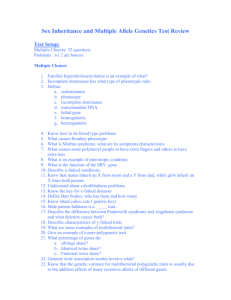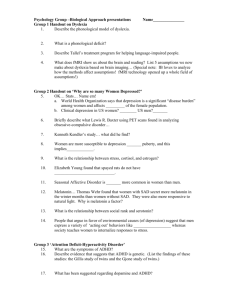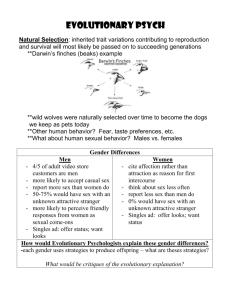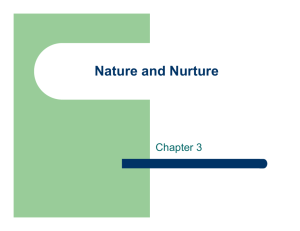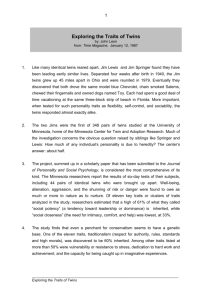- Our Political Nature
advertisement
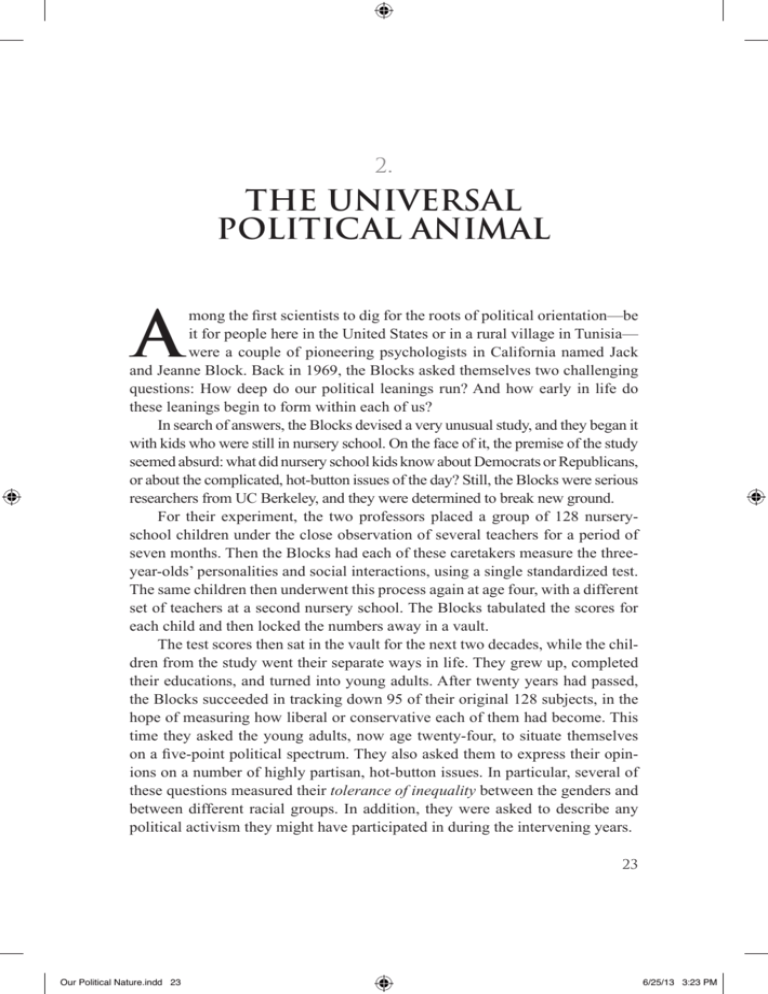
2. The Universal Political Animal A mong the first scientists to dig for the roots of political orientation—be it for people here in the United States or in a rural village in Tunisia— were a couple of pioneering psychologists in California named Jack and Jeanne Block. Back in 1969, the Blocks asked themselves two challenging questions: How deep do our political leanings run? And how early in life do these leanings begin to form within each of us? In search of answers, the Blocks devised a very unusual study, and they began it with kids who were still in nursery school. On the face of it, the premise of the study seemed absurd: what did nursery school kids know about Democrats or Republicans, or about the complicated, hot-button issues of the day? Still, the Blocks were serious researchers from UC Berkeley, and they were determined to break new ground. For their experiment, the two professors placed a group of 128 nurseryschool children under the close observation of several teachers for a period of seven months. Then the Blocks had each of these caretakers measure the threeyear-olds’ personalities and social interactions, using a single standardized test. The same children then underwent this process again at age four, with a different set of teachers at a second nursery school. The Blocks tabulated the scores for each child and then locked the numbers away in a vault. The test scores then sat in the vault for the next two decades, while the children from the study went their separate ways in life. They grew up, completed their educations, and turned into young adults. After twenty years had passed, the Blocks succeeded in tracking down 95 of their original 128 subjects, in the hope of measuring how liberal or conservative each of them had become. This time they asked the young adults, now age twenty-four, to situate themselves on a five-point political spectrum. They also asked them to express their opinions on a number of highly partisan, hot-button issues. In particular, several of these questions measured their tolerance of inequality between the genders and between different racial groups. In addition, they were asked to describe any political activism they might have participated in during the intervening years. 23 Our Political Nature.indd 23 6/25/13 3:23 PM 24 Introduction The results, published in 2006 by the Journal of Research in Personality, were astonishing.1 In analyzing their data, the Blocks found a clear set of childhood personality traits that accurately predicted conservatism in adulthood. For instance, at the ages of three and four, the “conservative” preschoolers had been described as “uncomfortable with uncertainty,” as “rigidifying when experiencing duress,” and as “relatively over-controlled.” The girls were “quiet, neat, compliant, fearful and tearful, [and hoped] for help from the adults around.” Likewise, the Blocks pinpointed another set of childhood traits that were associated with people who became liberals in their mid-twenties. The “liberal” children were more “autonomous, expressive, energetic, and relatively undercontrolled.” Liberal girls had higher levels of “self-assertiveness, talkativeness, curiosity, [and] openness in expressing negative feelings.”a The Blocks’s experiment suggested that the roots of our political orientations emerge as early as the fourth year of life. But it begged further, essential questions: Would children from different regions or socio-economic backgrounds diverge into similar personality groups? And how much deeper are the origins of these crucial personality traits? When the Blocks’s findings are connected with other relevant studies in genetics, neuroscience, and anthropology, a composite image of our political nature begins to emerge, which few people have ever contemplated. As this portrait of ourselves comes into focus, we will learn what made some of those nursery-school children grow up to become liberals, and some of them, conservatives. We will discover exactly how deep the roots of our political proclivities extend, and why they have a similar influence on children in America, the Middle East, and most everywhere else. The reason for these crosscutting commonalities, as we’ll see in this chapter, is because political orientations are natural dispositions that have been molded by evolutionary forces. Taken together, those deeply ingrained political orientations form what could be called “The Universal Political Animal.” The Deepest Origin of Political Attitudes To begin with, exactly how far down do the roots of preschoolers’ political orientations extend? Do these roots somehow spring from the hard wiring they were born with? Perhaps W. S. Gilbert, the nineteenth-century English dramatist and poet, was onto something when he mused: Our Political Nature.indd 24 6/25/13 3:23 PM The Universal Political Animal 25 I often think it’s comical How nature always does contrive That every boy and every gal That’s born into this world alive Is either a little Liberal Or a little Conservative2 In the early 1990s, the University of Minnesota’s Center for Twin and Family Research set out to test Gilbert’s humorously posited theory. Armed with a valuable list of ten thousand twin pairs and their family members, these scholars had a unique way to determine whether our genes—as opposed to our environment—exert any effect over our political convictions. The Minnesotan scientists began their study with a left-right political-­ orientation test called the RWA scale, which we’ll learn about in great detail in the following chapters. They handed it out to over fourteen hundred identical and fraternal twins. Each pair was raised in the same family. In a parallel study, psychologist Thomas Bouchard gave the same test to a very special subset of siblings: eighty-eight identical twins and forty-four fraternal twins raised in completely different environments. Figure 1. Correlations between the Political Orientations of Identical and Fraternal Twins, Raised Together and Apart. Our Political Nature.indd 25 6/25/13 3:23 PM 26 Introduction Comparing both types of twins is crucial: in the case of twins raised together, the shared environment (such as family dynamics, interactions between twins, and social perceptions) could influence the development of the twins’ personalities. But for twins separated at birth, most of these confounding factors drop away; this makes it easier to chalk up their personality similarities to genetics. Figure 1 shows the correlations between the left-right orientations of twins raised together and apart (Appendix A explains correlations and the simplified notation used in this book). The black bars correspond to identical twins, and the gray bars to fraternal twins. The first two clusters show the twins raised together. Identical twins (who share 100 percent of their genes) had more similar political orientations than fraternal twins (who share only 50 percent of their genes, like normal siblings). The third cluster shows the amazing finding of Bouchard’s survey: identical twins reared apart had a strong correlation between their political orientations; but the scores of fraternal twins raised separately didn’t correlate significantly.3 These results suggest that genetics plays a decisive role in determining political attitudes. In other words, identical twins are more likely than fraternal twins to agree on divisive issues, precisely because they’re more closely related to one another. To make this idea more concrete, let’s consider a few specific hot-button issues: “capitalism,” “segregation,” and “immigration.” These three words come from the twenty-eight items on the Wilson-Patterson Conservatism Scale, which political scientist John Alford has researched at Rice University. These terms are guaranteed to set off the hidden triggers of political polarization. In the first case, conflicting attitudes toward “capitalism” are essentially what have divided Tea Partiers from Occupiers. Why? Because unfettered free markets reflect and create inequalities, to which people have varying levels of tolerance, depending on their political personalities. Words like “segregation” and “immigration,” on the other hand, evoke opposing attitudes toward tribalism—another of the three universal personality clusters. In 2005, Alford asked nine thousand identical and fraternal twins to agree, disagree, or express their uncertainty toward these three words and twenty-five others like them. Positive responses to half of the twenty-eight items raise one’s conservatism score, and positive responses to the other half lower one’s score. Negative reactions do the opposite. Alford’s twins considered these terms and wrote down their answers. Amazingly, for every single item, the identical twins’ political orientations correlated more strongly than they did for the fraternal twins. And in every case, the difference in strength was significant.4 Alford’s experiment and others like it consistently show that 40 to 60 percent of the variation in our political atti- Our Political Nature.indd 26 6/25/13 3:23 PM The Universal Political Animal 27 tudes comes from genetic differences between individuals.5 The remaining differences come from environmental factors.b Alford’s findings suggest that the Blocks’s nursery-school children weren’t inevitably predestined to become Republicans or Democrats. Nonetheless, their adult opinions on controversial issues ran even deeper than their childhood personality traits; a substantial proportion of their political dispositions stemmed from their genetic makeup. It’s only a matter of time before scientists identify specific parts of our genetic makeup that may influence political orientation. In fact, they’re already beginning to do so: in 2011 researchers from the Virginia Institute for Psychiatric and Behavioral Genetics joined hands with colleagues from the Queensland Institute of Medical Research, and they took DNA samples from over thirteen thousand individuals who had taken the same kind of liberalism-conservatism test given by Alford. Then, the scientists conducted the first genome-wide linkage analysis to search for genes that correlated with political attitudes. The genomic regions they identified accounted for up to 13 percent of the variation in their subjects’ political orientation.6 Chief among these candidates was a gene on Chromosome 4 for a neurotransmitter receptor called NARG1. This particular receptor binds an amino acid derivative called NMDA. And NMDA has been associated with fear conditioning, as well as prosocial, antisocial, and aggressive behaviors.7 Including this work, six published studies thus far have explored over a dozen genes that may affect political orientation. And additional articles are currently in press. The early study mentioned here is undoubtedly an important milestone. But based on current trends in genetics, it’s likely that future research using more powerful techniques (such as genome-wide association studies) and sample sizes ten to twenty times larger, will soon make much more definitive discoveries. It’s important to bear in mind that a complex trait like political orientation will undoubtedly be influenced by an extremely large number of genes. Although a tremendous amount of work remains in order to find and understand them, we’ll have a chance in the coming chapters to learn about a few specific cases where we can already see the influence of genes on political behavior. Because our political attitudes have such deep roots, we don’t normally undergo radical ideological shifts later in life. As people pass through their thirties, forties, fifties, and sixties, their identities stay quite stable; when measured from one decade to the next, the average individual’s political orientation correlates very strongly with itself (at .80).8 Political attitudes do in fact change over time. But they change at predictable ages, and in foreseeable directions. We’ll learn much more about this natural tendency in chapters 18 and 21. Our Political Nature.indd 27 6/25/13 3:23 PM 28 Introduction The Universality of Left and Right When we talk about our specific political convictions, we think of them as lying somewhere on a spectrum between a “left” and a “right.” These terms come from the 1791 French Legislative Assembly, where monarchists sat on the right and antimonarchists sat on the left.9 But exactly how far do these concepts transcend their origin? Are notions of left and right more relevant to Californians than they are to Tunisians? Does everyone have a left-right orientation? The National Election Studies, which are the leading survey of voters in US presidential polls, have found that over three quarters of Americans feel comfortable pinpointing their views on a two-dimensional political spectrum. Over 90 percent of college students will do the same, even when they’re allowed to not participate. Collecting people’s liberal-conservative self-placements is useful because they correlate very strongly with their actual voting habits.10 How does the United States compare to the rest of the world? For the past thirty years, a global network of social scientists has researched basic beliefs across every habitable continent. Periodically, they produce a colossal report called the World Values Survey. Between 1981 and 2008, these surveys asked almost three hundred thousand people from ninety-seven countries if they were willing and able to place themselves on a left-right spectrum. Only 3 percent chose not to answer, and 18 percent chose “Don’t know.” But nearly eight out of ten people in the world identified with a particular political orientation. Since the surveyors operate in many authoritarian countries, many of the nonresponders probably considered it safer not to express a political opinion. Indeed, people in (historically) less democratic countries are not as willing or able to tell a researcher their ideological orientation. For example, only 46 percent of Algerians would do so, compared with 77 percent of Eastern Europeans, and 88 percent of Western Europeans.11 Of the great majority of people around the world who will express an ideology to a surveyor, we find an intriguing pattern in their responses. The World Values Survey always asks: “In political matters, people talk of ‘the left’ and ‘the right.’ How would you place your views on this [ten-point] scale, generally speaking?” Figure 2 shows how over a quarter million people answered this question. This chart approximates a bell-shaped curve.c Measures of our bodies (such as height, weight, and blood pressure) frequently form a similar, natural shape; graphs of income distribution, however, seldom do. If we were to graph the political orientations of every country separately, each population wouldn’t necessarily produce the same exact left-right curve Our Political Nature.indd 28 6/25/13 3:23 PM The Universal Political Animal 29 on the same segment of an absolute scale. Indeed, public opinion in certain countries skews further to the right (as in Communist Vietnam) or to the left (as in Mugabe’s Zimbabwe). In addition, some countries have narrower or broader spectrums; we’ll learn what determines a spectrum’s breadth in the next chapter. The important point, though, is this: ordinary people everywhere use the concepts of “left” and “right” to describe their political orientations. And the experts agree with them about the existence of this spectrum. A survey once asked fifteen hundred professional political analysts if they could easily place political parties on a left-right scale, in their forty-seven countries of specialization. Virtually none of them had any problem in doing so.12 Figure 2. Global Self-Positioning on the Left-Right Political Spectrum (251,724 people in 97 countries, 1981–2008). So the left-right political spectrum is universal. It forms a natural, bell-shaped curve. Some countries have wider or narrower spectrums. But how can we know whether the left-right orientations of groups as a whole compare with one another? In other words, are the Blocks’s children as conservative or as liberal as their counterparts in Tunisia? In psychology, there are a few standard personality traits that have been measured across truly diverse human groups. They belong to a well-tested Our Political Nature.indd 29 6/25/13 3:23 PM 30 Introduction and widely accepted inventory called the “Big Five” personality dimensions. Specifically, these traits are Openness, Conscientiousness, Extraversion, Agreeableness, and Neuroticism (it’s easy to remember them because they spell out OCEAN). The first three dimensions (O, C, and—to a lesser degree—E) correlate fairly well with left-right voting. Therefore, these traits can serve as a universal yardstick for measuring the dispositions of disparate cultures, which would otherwise be difficult to compare in reference to specific political issues. Psychologist Robert McCrae, with the help of his colleagues from numerous countries, has collected measures of these Big Five dimensions from nearly twenty-eight thousand people of thirty-six distinct cultures around the world. The participants represented the Indo-European linguistic family, as well as the Uralic (Finland, Hungary, Estonia, etc.), Dravidian (South India), Altaic (Turkic, Mongolic, etc.), Malayo-Polynesian, Sino-Tibetan, and Bantu (SubSaharan Africa) ethno-linguistic groups. Variation in these Big Five personality traits was greatest within cultures. This finding makes intuitive sense, since a given population has a bell-shaped distribution of left-right political orientation. Moreover, Big Five dimensions such as Openness and Conscientiousness also form bell-shaped curves within a population. In addition to the large variation within cultures, however, McCrae, together with his colleague Jüri Allik, also discovered small variations in personality traits between groups. Conscientiousness, which predicts conservative voting, moderately correlated with proximity to the equator. And Extraversion, which is associated with liberal voting, correlated strongly with greater distance away from the equator. Temperature also mattered. Hotter climates correlated strongly with Con­ scientiousness. So even though a political spectrum runs through all populations, groups closer to the equator (and in hotter environments) have a more conservative average group disposition than groups living further away from the equator (and in cooler climes). What happened when groups of very different genetic backgrounds live in the same environment? In this case, each group’s average personality scores differed according to the origin of their ancestors. For example, the personality traits of white South Africans clustered closer to the Swiss, while black South Africans had personalities more similar to Zimbabweans. Likewise, groups that have traditionally lived in geographically adjacent territories have more similar average personalities than groups separated by large distances. There is a chance that these facts could be explained by culture or by the direct effect of the environment. However, they suggest that populations around Our Political Nature.indd 30 6/25/13 3:23 PM The Universal Political Animal 31 the world have personality distributions that are genetically adapted to their ancestral environments.13 We’ll unravel this mystery much further in chapter 10. Political Orientations in the Brain: What an MRI Can Show A skeptic might question whether it’s really possible to study something as fuzzy and subjective as personalities in a scientific way. Is there any concrete, physiological evidence that could explain the apparent differences in our political personalities? On a BBC program in 2010, the Oscar-bound actor Colin Firth laid down a tongue-in-cheek challenge. He asked scientists to find out what was “biologically wrong” with people who didn’t agree with him on political matters.14 In response, researchers at University College London recruited ninety students, and had them confidentially place themselves on a five-point political spectrum, just as the Blocks’s twenty-four-year-olds had done. Their choices could range from “very conservative” to “very liberal.” Then neuroscientist Geraint Rees used magnetic resonance imaging (MRIs) to scan each of their brains. The results were stunning. From the MRIs, the scientists were able to accurately predict which of those individuals was more likely to be a liberal or a conservative. The more conservative students had a larger right amygdala; greater liberalism, on the other hand, was associated with a larger anterior cingulate. Figure 3 shows the correlations between political self-placement and the volume of these brain regions. Someone who only had the measurements of these two brain regions would be able to correctly guess whether an individual was “conservative” or “very liberal” about 72 percent of the time (no student identified as “very conservative”). Aside from the right amygdala and the anterior cingulate, no other regions showed a significant and independent correlation with political orientation. An additional study later replicated the same findings. The researchers noted that the amygdala has an emotion-processing function, which could explain why conservatives are more sensitive to threatening facial expressions than liberals are.15 As we’ll discover in chapter 19, this variation in the amygdala likely corresponds to differences in our perceptions of human nature, and these perceptions constitute one of the three personality clusters that underlie political orientation. In the course of this book, we’ll learn about fascinating findings from neuroscience, and other physiological differences between liberals and conservatives. Our Political Nature.indd 31 6/25/13 3:23 PM 32 Introduction Some of these studies, such as this one, cannot determine whether political attitudes originate in the brain, or whether learning attitudes from others changes the structure of the brain (we know that the brain can change through training and gaining new skills). But other experiments do clarify the direction of the causation. Figure 3. Correlation between the Size of Two Brain Regions and Political Orientation. Finding Ourselves in the Big Picture All right, so perhaps there are physiological differences between liberals and conservatives—although we’ll definitely want to learn more to be convinced. Our Political Nature.indd 32 6/25/13 3:23 PM The Universal Political Animal 33 Does this mean that it’s possible to think about political conflict from a biological perspective? Surely politics is a uniquely human phenomenon that our species has developed long after we evolved fully modern “hardware,” right? Not so, according to one of the world’s most renowned primatologists. Academy of Sciences member Frans de Waal has written a book called Chimpanzee Politics: Power and Sex among Apes. His book describes the complex political life of our closest living relatives. De Waal recounts in detail how chimpanzees form alliances between small groups of high-status individuals. And he tells of their betrayals and realignments, and of the brutal murders of chimpanzees fighting for social status (and mating opportunities) within a troop. In one case, political rivals went far beyond simply killing an alpha male named Luit; they even ripped off Luit’s toes and fingernails, and pounded out his testicles. Most chimp violence occurs between males, however females indirectly support male candidates for high positions by cheering and even intervening during conflicts.16 In addition to rudimentary political factions within their troops, chimpanzees have personalities that are meaningfully similar to ours. Groups of human caretakers have separately scored large numbers of chimpanzees on the Big Five factors, and their independent ratings of each dimension coincide with each other for individual apes. The importance of this discovery is not just that chimps have variable personalities; rather, it’s that they are the only animals known to have traits analogous to all of our Big Five factors (in addition to a sixth factor of their own called Dominance). Biologists have found personality traits similar to Agreeableness, Neuroticism, and Extraversion across some twenty primates and other mammals. But Openness is less common; for example, it’s only partially present in the semi-social orangutan. And full Conscientiousness has only been found so far in humans and chimpanzees.17 Openness and Conscientiousness, as we’ve just learned, are the personality dimensions that best correlate with left-right voting in human beings. But before we focus on particular personality traits and their evolutionary roots, it’s vital to make sure that we aren’t overlooking shallower conflicts that could more easily explain our political battles. What about simple self-interest? Does your income bracket explain how you feel about paying taxes? Does having or lacking health insurance determine what you think about President Obama’s controversial healthcare-reform bill? Economics does in fact influence politics, as we’ll see in the next chapter—just not in the way that most people expect! Our Political Nature.indd 33 6/25/13 3:23 PM



